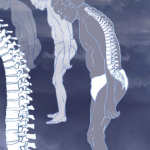Axial spondyloarthritis (SpA) is a chronic inflammatory disease predominantly affecting the sacroiliac joints and spine. The disease comprises two subpopulations: those with radiographic axial SpA (also known as ankylosing spondylitis) and those with nonradiographic axial SpA, who have been reported to have a similar disease burden. Conventional therapy for axial SpA comprises nonpharmacologic management, such as physical therapy, and non-steroidal anti-inflammatory drugs (NSAIDs) as first-line treatment. In routine clinical practice, patients are also treated with conventional disease-modifying anti-rheumatic drugs (DMARDs), corticosteroids and analgesics. However, for patients with active disease and objective signs of inflammation (sacroiliac joint inflammation on magnetic resonance imaging [MRI] or elevated C-reactive protein [CRP] level) despite treatment with NSAIDs, treatment with anti-tumor necrosis factor (anti-TNF) agents has been recommended.
Our understanding of disease presentation, progression and prognosis of nonradiographic axial SpA is imperfect and incomplete. Some experts have suggested nonradiographic axial SpA could be a self-limiting disease, with the potential for spontaneous remission. This, in part, has resulted in the lack of access to anti-TNF agents for many patients with nonradiographic axial SpA in several countries. And NSAIDs may provide inadequate disease control in patients with active disease.
Thus, the authors of this study chose to investigate the effects of certolizumab pegol (CZP), an anti-tumor necrosis factor treatment, in nonradiographic axial SpA patients with objective signs of inflammation.
Methods: In this ongoing parallel-group double-blind study, adults with active disease were recruited from 80 centers in Australia, Europe, North America and Taiwan and randomized 1:1 to receive placebo or CZP (400 mg at Weeks 0, 2 and 4, followed by 200 mg every two weeks), administered via a prefilled syringe, in addition to nonbiologic background medication (e.g., NSAIDs; conventional DMARDs, such as sulfasalazine, methotrexate, hydrochloroquine, oral and intravenous corticosteroids; and opioid and nonopioid analgesics). Switching to open-label CZP (or other biologic) or making background medication changes was permitted at any point, although changes before Week 12, or within four weeks prior to Weeks 24 and 52, were discouraged.
The primary end point was the proportion of patients achieving major improvement (i.e., a ≥2.0-point decrease in the score from baseline or achievement of the lowest possible score [0.6]) in the Ankylosing Spondylitis Disease Activity Score (ASDAS) at Week 52. The ASDAS comprises five elements: patient’s self-reported back pain, peripheral pain/swelling in joints, duration of morning stiffness (all from the BASDAI questionnaire), Patient’s Global Assessment of Disease Activity (PGADA), and CRP level.
Results: A total of 317 patients were randomized to receive placebo plus a nonbiologic background medication (n=158) or CZP plus a nonbiologic background medication (n=159). Major improvement in the ASDAS at Week 52 was achieved in 47.2% (75 of 159) of patients in the CZP plus a nonbiologic background medication group, which was significantly greater (P<0.0001) than 7.0% (11 of 158) in the placebo plus a nonbiologic background medication group. In that group, 60.8% (96 of 158) switched to open-label treatment before Week 52 compared with 12.6% (20 of 159) of the CZP plus a nonbiologic background medication group.
Conclusion: Adding CZP to background medication is superior to adding placebo in patients with active nonradiographic axial SpA. These results indicate that remission in nonradiographic axial SpA treated without biologics occurs infrequently, demonstrating the need for treatment beyond nonbiologic therapy.
Excerpted and adapted from:
Deodhar A, Gensler LS, Kay J, et al. A 52-week, randomized, placebo-controlled trial of certolizumab pegol in nonradiographic axial spondyloarthritis. Arthritis Rheumatol. 2019 July;71(7):1101–1111.
